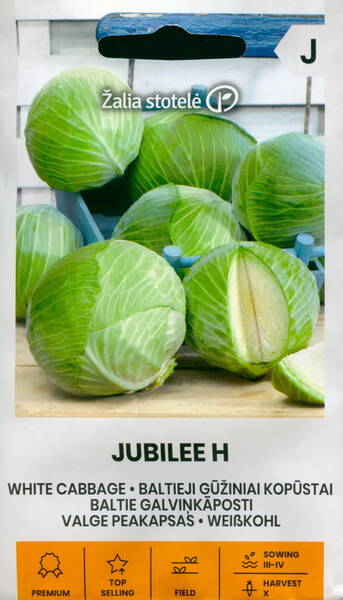Ex Tax: 1.45€
Late yielding hybrid variety with a strong root system. Vegetation period is 149 days from planting the sprouts. Planted till May 15th. Loafs are very large, round leaves covered with a layer of wax, the inner core is short. Suitable for pickling in autumn, long storage and pickling in winter. Grow well in water permeable, non-acid, moderate and light loamy soil. Disinfected seeds protect the crop from diseases for 14 to 30 days.
1,0 g = 250-350 seeds.
* Life cycle: white cabbage is a biennial plant grown in an annual crop; cauliflower is an annual plant.
Growing conditions: in open ground, under film covers.
Seeds: white cabbage - 250-350 pieces per 1 g, cauliflower - 300-400 pieces per 1 g.
Sowing: 40-45 days before planting seedlings. When growing early products, sowing is carried out in heated glass or film greenhouses to a depth of 1-2 cm. When growing seedlings in cassettes, 1 seed is sown in each cell. When growing through a pick, 1.5-2 g of seeds per 1 m2 are sown. Water after sowing. Before the appearance of the first shoots, crops can be covered with a film.
Germination: the optimum temperature for seed germination is +18..+20°С. Shoots appear in 3-5 days. After the appearance of single shoots, the film is removed. After germination of about 50% of the seeds, the temperature is lowered to +12..+15°C.
Growing seedlings: dive in the phase of developed cotyledons or when the first true leaf appears (when growing through a pick). The soil is not waterlogged to prevent the development of the "black leg". If necessary, carry out 1-2 top dressing with complex fertilizers. For 10-14 days before planting, hardening of seedlings begins: they increase ventilation, reduce watering, and lower the temperature.
Disembarkation: seedlings are planted at the age of 35-40 days. In the middle lane, the term for planting seedlings of early white and early cauliflower is from April 25 to May 5. Before spring tillage, fertilizer is applied at the rate of 2-2.5 kg N, 0.75-0.8 kg P205, 2.5-3.0 kg K20 per 100 m2 (cauliflower requires a slightly smaller amount of nitrogen and more potassium ). When planting cauliflower, boron and molybdenum are also added. Chlorine fertilizers should be avoided. Planting scheme for early white cabbage - 50 x 30-40 cm (depending on the variety), early cauliflower - 70 x 40-50 cm (depending on the variety). Water wells thoroughly before planting.
Soil: well-drained, fertile, loamy (for cauliflower, necessarily rich in humus and nutrients in an accessible form), pH 6-7, moisture-intensive, with a deep arable horizon.
Temperature: cabbage is a cold-resistant plant. Well-hardened seedlings after planting in the field (on the plot) endure short-term frosts down to -2..-5°C. During the growing season, the optimum temperature is +15..+18°C.
Watering: keep the soil moist. With reduced soil and air humidity, plants develop poorly, form few leaves and small heads. Optimum soil moisture is 75-80%, relative air humidity is 85-90%. If necessary, watering is carried out every 6-8 days. At the end of the growing season, watering is undesirable to avoid cracking heads.
Nutrition: to obtain high yields, plants are fed 2-3 times after planting. The first top dressing is carried out with nitrogen fertilizers, the rest - with complex ones.
Ripening: early varieties and hybrids are suitable for harvesting 50-60 days after transplanting.
Useful cabbage.
Cabbage is an inexhaustible source of essential amino acids, which are necessary for hematopoiesis, tissue growth and repair, stimulation of the functions of the kidneys, adrenal glands, thyroid gland, as well as the dissolution and removal of foreign proteins from the body.
Cabbage is famous for vitamins U and K: vitamin U is able to cure stomach and duodenal ulcers, ulcerative colitis, gastritis and intestinal lethargy and activates liver functions, and vitamin K is necessary for normal metabolism, wound healing, blood clotting, bone formation and healthy teeth helps the liver work.
Cabbage is of particular value as a source of vitamin C. This vitamin can be present in cabbage in the same concentration for 7-8 months.
Cabbage has almost no starch and very little sucrose, so it is good for diabetics.












